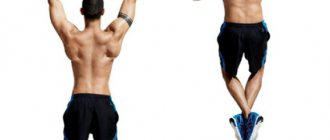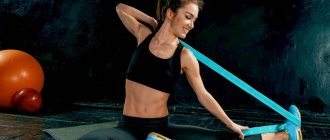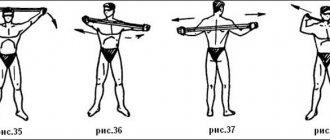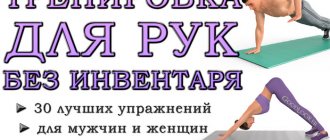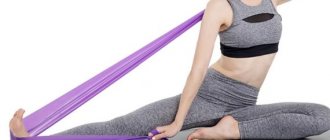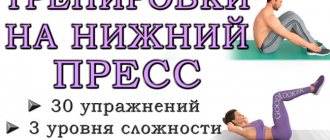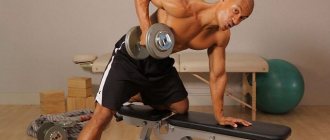The phenomenon of CrossFit appeared relatively recently, but instantly became a new sport and gained many followers around the world. This technique combines both strength training and gymnastic exercises, and does not leave any professional athlete indifferent. Every year, more and more new exercises are included in CrossFit programs and complexes, which further increases the number of fans of this sport.
- What is CrossFit?
- Video: What is CrossFit?
- Benefits of doing CrossFit
- Fundamental Principles of CrossFit Training
- Strength training with iron
- Crossfit training with barbell
- Linda exercise set
- Video: How to perform the Linda CrossFit complex
- Barbell complex
- Video: Barbell complex, execution
- Snatch EMOM
- Video: Barbell snatch. Execution technique and main mistakes
- Bear complex
- Video: Correct execution of the bear complex
- Crossfit workout with dumbbells
- Video: Variations of the correct execution of the Man Maker exercise
- Crossfit workout with kettlebells
- Home bodyweight training program for men and women
- Video: Home cross fitness program
- CrossFit weight loss program
- Tips and tricks for doing CrossFit
What is CrossFit?
CrossFit is a set of physical exercises for strength and endurance. Spouses Greg Glassman and Lauren Jenay in the 90s of the last century decided to create a program aimed at optimizing a person’s physical capabilities on all fronts: from cardiovascular, respiratory and muscular endurance, to pumping strength, power, flexibility, accuracy, speed, agility , coordination and balance. The plan was realized in 1995, when the first specialized hall was opened in the USA. Four years later, the technique began to spread in other countries, and seven years later the first CrossFit games were held, which are still an annual event in the world of sports. In Russia there is a franchise and affiliate of CrossFit Den. The first Russian championship took place in 2012.
CrossFit workouts incorporate the best elements of many sports, such as:
- Weightlifting
- powerlifting
- gymnastics
- swimming
- aerobics
- run
- depth jump
When performing CrossFit exercises, a huge amount of sports equipment is used:
- barbells, dumbbells and weights
- gymnastic rings and horizontal bars
- jump ropes, medicine balls and expanders
- jumping pedestals (plyo boxes)
- rowing machines
The effectiveness of CrossFit has been recognized and introduced into their training programs by many departments of law enforcement agencies, fire departments and military organizations.
Video: What is CrossFit?
How to do CrossFit at home correctly
To begin with, it is important to understand the very essence and specifics of CrossFit. It doesn't have to be a regular workout program, HIIT, Tabata or classic fitness. A scheme is needed that will use exactly CrossFit modes (AMRAP, EMOM and others). There are a lot of possibilities in this matter, so it is best to choose based on your goals. For example, for the simultaneous development of extreme endurance, strength and muscle mass, EMOM training shows excellent results. Their essence is to do a certain amount of load at the beginning of each minute, and then rest for the remaining time. Usually this is about 5 seconds of work and 40-45 seconds of rest. As fatigue increases - 30/30.
The key to training is proper application and understanding of metcon. This is an analogue of the term WoD, which is more applicable in practice. Metcon is a classic workout and the main difference between CrossFit and other strength sports. Main features of metcon:
- Performing all exercises with maximum intensity (most often it is prioritized over the weight of the equipment), therefore, develops endurance and peak performance.
- Reducing the rest between exercises to a minimum - restoring breathing. This makes each complex short in time and intense.
An important point to pay attention to is load scaling. You can’t do without it in home CrossFit, but any scaling must be correct, otherwise the workouts will turn into regular fitness with limited sports equipment.
The final element of CrossFit that you should definitely use is creating a plan for each workout. Moreover, the plan of the day (WoD) should be selected so that each microcycle contains different loads that work out all muscle groups equally in a balanced manner.
Benefits of doing CrossFit
CrossFit comprehensively improves physical fitness, and the following factors serve as proof of this:
- exercises in the program are aimed at training the strength and endurance of the whole body;
- CrossFit includes a lot of exercises, this significantly distinguishes it from other physical practices, where the actions are often monotonous and monotonous;
- despite the abundance of required equipment, you can practice CrossFit at home;
- Don’t forget that CrossFit is available to both men and women.
What is the minimum equipment needed for CrossFit at home?
It is quite difficult to assess what home equipment a particular athlete needs. This is due to the fact that athletes with different levels of training and fitness will need different amounts of equipment. However, the beauty of the discipline is that thanks to the scaling and variability of the loads, you can adapt your CrossFit workouts to whatever equipment you have at hand.
There are several approaches to choosing equipment; they have significant differences, but allow you to train perfectly even at home:
- Without equipment - the most “primitive” option, excellent for preparing the body for subsequent hard work with equipment. CrossFit calisthenics has a lot of advantages, but quickly reaching the development level can be considered a disadvantage.
- With dumbbells - this option allows you to perform most of the movements. If you have the opportunity to choose only one apparatus, then dumbbells will be the best option (optional - kettlebells, although their capabilities in the variety of loads are slightly lower).
- A complete set - the best option for beginners includes: sandbag, dumbbells/weights, rubber bands. For advanced athletes, it's worth adding a CrossFit hammer and tire.
In general, CrossFit has a fairly large number of different types of loads and exercises, which allows you to work effectively with any set of equipment, and even without it.
Fundamental Principles of CrossFit Training
The main principle of CrossFit training is the correct alternation of exercises. When building a training program, exercises that use the same muscles should not be placed nearby . The expression “the main thing is quality, not quantity” comes in handy here. Before starting to master this type of training, the trainer selects an individual exercise technique for each athlete. Despite the fact that CrossFit can be done at home, it is still worth seeking the help of a trainer at first. The help of a professional will be useful for “laying the necessary foundation.” The training itself is usually divided into three segments: weightlifting, gymnastics and cyclic training. As with any other type of physical activity, special attention should be paid to execution technique, on which the effectiveness of the entire program depends.
In CrossFit, exercises are performed in rounds. Round - performing a given number of exercises in the complex. When working with the classic program, perform 5-7 rounds, after which rest until the oxygen supply in the body is completely restored.
Recommendations
- Any training, whether in the gym or at home, should begin with a quality warm-up. In addition to cardio exercises and warming up your joints, it doesn’t hurt to prepare your muscles with simple auxiliary exercises for stabilizer muscles, such as hyperextension. The exercise will tone the lower back muscles, which will prepare the back to stabilize the spine during heavy power loads.
- Think over your training plan in advance, or better yet, draw it up a week in advance.
- Do not attempt to perform the program with the weight or amount prescribed in the complex if you cannot handle this load. Reduce the intensity: speed, number of rounds, weight, repetitions so that the workout is effective and does not end on the first repetition.
Home bodyweight training program for men and women
You can do CrossFit at home; you don’t need to purchase expensive sports equipment, just buy dumbbells and don’t forget about running. There are many home CrossFit programs. You can do wod (workout of the day) programs from the wodcat database or take a ready-made workout described below. One program usually includes at least three exercises from the following list:
- push ups
- run
- burpee
- pull-ups
- jumping on a stand
- jumping rope
- squats and lunges
- body lifts
- dumbbell press and row
One of the most famous programs called “Cindy” consists of the following exercises:
- pull-ups on the horizontal bar
- classic push-ups
- squats
And its essence is this: in 20 minutes, the athlete tries to complete as many rounds of 5 pull-ups, 10 push-ups and 15 squats as possible.
Pull-ups
- Grab the bar with a medium overhand grip.
- Using the strength of the muscles of the arms and back, we perform pull-ups so that the chin is above the bar.
- We perform all movements smoothly and without sudden movements.
Performing classic pull-ups
Push ups
- We take the starting position with emphasis on the toes and straight arms.
- We slowly lower ourselves, literally touching the floor with our chest.
- Inhale, then exhale and rise to the starting position, tensing the pectoral muscles.
Pushups
Squats
- Feet shoulder-width apart, knees slightly bent, arms crossed over chest.
- Inhale and, keeping your back straight, perform a squat without lifting your heels from the floor.
- We exhale and rise smoothly.
Performing squats
After completing the first round, almost immediately proceed to the second. The challenge for a beginner is to complete 7 rounds in 20 minutes.
Video: Home cross fitness program
Basic exercises
Next, we will look at the basic movements that a beginner should start with in the first month of training.
Burpee
Burpees are the most famous exercise in CrossFit. It has become a kind of calling card of this training system. It belongs to the gymnastic class, that is, to work with it you only need your own body and nothing else.
Burpees are great for training endurance, which is so necessary for a beginner in CrossFit.
© logo3in1 — stock.adobe.com
Deadlift
Deadlifts are the basis of Crossfit training. The movement comes from weightlifting and works great on the legs, gluteal muscles and back muscles. In addition, it will be a good start for beginner athletes when training with free weights. Thanks to it, you can understand the basic principles of following the technique of performing various lifts of the barbell. Having worked the deadlift properly, it will be much easier to move on to cleans, snatches and jerks.
Pull-ups, squats and push-ups
Let's not dwell long on pull-ups, air squats and push-ups - these exercises are familiar to us from school. They are basic gymnastics for beginners and should definitely be included in the training program.
Jumping rope
Rather, even double jumping rope is a very useful exercise. Refers to the cardio block. Excellent for developing overall endurance and coordination of the whole body. Must be used in training for beginners.
Press press
The Shvung Press with a barbell is an excellent strength movement. Refers to weightlifting. Works the legs (calves, buttocks and thighs), the main emphasis is on the deltoids and triceps. Recommended for inclusion in the program for beginners.
Plank
The plank perfectly works the abdominal muscles (abs program in the gym and at home). Perfect for working after the main workout as an additional workout for the core muscles.
© Makatserchyk — stock.adobe.com
Sit-ups
Sit-ups or V sit-ups - raising the body from a lying position (in the case of V, raising both the body and legs from the same position). The movement works well for the abs and overall endurance.
© Flamingo Images - stock.adobe.com
Kettlebell swings
There are quite a few types of kettlebell swings in CrossFit, but two-arm swings are the basis for inclusion in initial training. They perfectly pump up the legs, buttocks, deltoids, back muscles and core.
© Daxiao Productions - stock.adobe.com
Cardio
And, of course, cardio exercises such as running, rowing, air biking should be included in the CrossFit training program for beginners, depending on what exactly is in your gym. If you have everything, great, you will need to alternate. If not, then replace one with the other.
© romaset — stock.adobe.com
CrossFit weight loss program
Due to its energy consumption, this type of physical activity, which seems to be more aimed at gaining muscle mass, is also excellent for losing weight. A personal trainer can easily create such a program for you in the gym, so let’s turn to the most popular set of weight loss exercises that you can do at home.
- 20 classic push-ups
- 20 squats with dumbbells: throughout the entire exercise, dumbbells are raised overhead with straight arms
- Burpees: 6 sets of 2 minutes each with 60 seconds rest between sets
- jumping rope for 2–3 minutes
The technique of doing push-ups, squats and jumping is known to almost everyone, but how to do burpees?
Burpees for endurance and weight loss
- We perform a squat with our palms on the floor in front of us.
- While jumping, we move our legs back (we get the starting position as for push-ups).
- We do push-ups.
- We return to the squat position.
- We jump up as high as possible, stretch our arms up and clap.
Burpees are a great exercise for burning fat.
The workout itself usually takes 10–15 minutes. Be sure to take rest days between classes and don’t forget about proper nutrition. Eat low-calorie foods (vegetables or fruits), as well as foods high in protein and complex carbohydrates. For a drink, use water or a protein shake. By the way, special diets have been developed especially for crossfit athletes - paleo and zone.
CrossFit loves and encourages experimentation, and therefore boring exercises can be easily replaced with others.
THIRD LOAD OPTION (Reduce time to complete a given amount of work)
You have a total number of reps to complete for each exercise. For example like this:
- 100 pull-ups
- 200 leg raises (abs)
- 200 push-ups
- 400 jumps with alternating legs
Please note: this is not the number of repetitions per exercise of the round. This is the TOTAL number of reps added up (for all the rounds you will do).
How many rounds (circles) should there be then? The peculiarity of this method of loading is that you decide how many circles (rounds) to do! You only have the TOTAL number of repetitions of the exercise that you need to do in total (in all circles) in total. It doesn’t matter how many circles you get. At least do one repetition per circuit exercise if you want. But remember that this load is FOR TIME, and with such a strategy you will lose it.
Basically you start with pull-ups. When your strength runs out (let’s say at 9 repetitions), you do not rest in order to complete the planned number of repetitions in the approach (there is no such number with this method). Instead, you move straight to the next exercise...then the next...until you get back to pull-ups. And here you start counting not from the 1st repetition, but from the 10th (because you have already done 9 before). Let's say you did 8 repetitions. This means that in total you will have 17... Returning through the circle, you will continue counting from the 18th repetition, etc...
WHAT IS TRAINED AT THE ENERGY LEVEL?
Each highly specialized sport trains highly specialized ways of providing energy to the work of different muscles. For example, if you train for maximum strength per repetition (like a powerlifter), you will develop ATP and CREATINE stores, which provide maximum energy, but only for a short period of time. If you train for maximum endurance, you will develop the OXIDATING abilities of your muscles, which are necessary for long-term and cheap energy supply with oxygen. If you are a bodybuilder and are developing strength performance, then you will develop GLYCOGEN reserves necessary for the resynthesis of energy through glycolysis.
Depending on the HEAVY and DURATION of the load, THIS or ANOTHER method of energy supply is turned on... So what method of energy supply works in CrossFit? Can someone clearly answer this question? No information available. So let's try to figure it out on our own...
ENERGY from ATP (1 sec)
Energy reserves in the form of ATP run out almost instantly after the start of the approach. Usually, within 1 second of starting a set, there is not enough ATP, and the body needs to restore its supply to continue working. Definitely, this method of energy supply will not be enough for CrossFit, because the approach lasts from several minutes to several tens of minutes.
BREAKDOWN OF CREATINE PHOSPHATE (5 sec-30 sec)
The first to work to restore ATP reserves is creatine, which binds to “empty” ADP and thus recreates an entire ATP molecule. This is called the Lohmann reaction (ADP + creatine phosphate = ATP + creatine.). This method is very “expensive” for our body, so it gets wasted quickly. It is literally only enough for a couple of repetitions for about 5 seconds. And after 30 seconds, creatine phosphate reserves will decrease by 50%. This method is suitable for weightlifting or powerlifting. For bodybuilding it will have much less importance. But it’s not suitable for CrossFit at all due to the duration of the approach.
GLYLCOLYSIS (30 sec - several minutes)
The next step in the work is the restoration of ATP using GLYCOGEN (carbohydrates) reserves. This chemical reaction of GLYCOLYSIS most often occurs without the participation of oxygen (ANAEROBIC) and is capable of QUICKLY RESTORE ATP reserves in muscles within 30 seconds. up to a couple of minutes. Moreover, this period does not depend on glycogen reserves, but on the WILL OF THE PERSON! With a long approach, the muscles begin to burn from the production of lactic acid (a by-product of glycolysis) and you have to force yourself to do the exercises.
This is where things get interesting. In theory, the interval is perfect and we can say that CrossFit is GLYCOLYSIS training! But keep in mind the fact that you are NOT loading the SAME MUSCLE throughout this entire time. If you did squats for 3 minutes, then I would say that this is pure glycolysis. But then you did 10 repetitions and moved on to another exercise. Those. the approach to the muscle stopped. Glycolysis certainly works, but not as an absolute method of energy supply.
Proof of this is the burning sensation. Experienced CrossFitters know that failure does not occur due to burning during work. Most often you feel tired. There is simply no energy in the muscles to lift even light weights. Those. the muscles don’t burn, and the muscles have no strength. This is very important because burning is the main symptom of long-term glycolysis. If it is not there, then there is no long-term glycolysis.
OXIDATION (from 4 minutes onwards...)
This is the last way to restore energy. It is the longest and “cheapest” because external oxygen is used, and not just internal reserves of substances (glycogen, amino acids, fats).
Oxidation occurs in two stages:
- First comes GLYCOLYSIS (see above) with the formation of 2 PYRUVATE MOLECULES
- Pyruvates penetrate into the mitochondria, where they are OXIDIZED in the “Krebs cycle” to CO2 (gas) H2O (water) and another 36 molecules of ATP!!! (this is 19!!! times more than with glycolysis).
C6H12O6 + 6O2 (oxygen) + 38 ADP + 38 H3PO4 = 6 CO2 + 44 H2O + 38 ATP
But since this process occurs in several stages and requires oxidation with oxygen, it takes longer. In addition, the maximum power of aerobic oxidation depends on the rate of oxygen supply and on the rate of its absorption into the muscle cell. All marathon runners train this ability in order to win long races. After all, any load whose duration exceeds 5-6 minutes can use only this (OXIDATING) method as energy supply.
It would seem that since oxidation allows you to work for 5-10 minutes, then this is exactly what is needed in CrossFit. But, friends, the problem is that we perform STRENGTH exercises primarily using fast-twitch muscle fibers, which have very few oxygen-absorbing mitochondria. Those. oxidation as an ideal source of energy is suitable for slow muscle fibers, and we use fast...
If you took a dumbbell for biceps weighing 1 kg and did a set for 5-10 minutes, then you would use aerobic oxidation. And since you take 10-20 kg, the energy runs out much faster and you have to restore it with the help of creatine phosphate, and then glycolysis.
ANSWERS
It seems to me that during CrossFit GLYCOLYSIS and OXIDATION are used most actively, and resynthesis from creatine phosphate is much less (possible only in the first rounds).
GLYCOLYSIS is used directly by working muscles during movement. But OXIDATION works more for “secondary muscle groups” that perform stabilization or movement. In general, doing easier work. Especially at the beginning.
You need to understand that the longer your CrossFit work lasts, the more oxidation products (such as lactic acid) accumulate in the muscles due to glycolysis and the more oxygen you need to eliminate it. And this happens from the VERY BEGINNING, and not just after 5 minutes of work. Oxygen needs increase and if your body is not able to satisfy them (there is no necessary training), then you have an OXYGEN DEBT!
During the first 4 minutes of CrossFit, the rate of oxygen consumption increases by more than 15 times. Moreover, if at first oxygen is not needed to remove lactic acid, then with each new approach it is needed more and more to remove this acid. Let me summarize. For a CrossFitter, the most important are GLYCOLYSIS (energy from glucose to form lactic acid) and INCREASED OXYGEN CONSUMPTION (i.e. reducing oxygen debt).
Loads in CrossFit are most often of a hybrid nature due to their duration. Here, in addition to strength, you are forced to train endurance and your oxygen capacity.
In addition, modern CrossFit uses the TABATA METHOD - a complex of simultaneous use of aerobic and anaerobic energy systems.
WHAT ARE THE TAKEAWAYS?
- Taking into account the methods of energy supply, we can say that in most cases (WODs), low-repetition approaches (1-3) will develop the necessary qualities worse than multi-repetition approaches (6-20).
- Failure is not necessary in CrossFit, because it will acidify the muscles too much with lactic acid and lead to a decrease in pace and a drop in strength.
- It is advisable to do a high-quality aerobic warm-up before performing the first round in order to help the body more easily adapt to the use of oxygen during long-term strength work and reduce oxygen debt.
- Rest after a series of rounds for as long as necessary to fully restore oxygen reserves in the body. This will help remove lactic acid and restore strength.
- Don't smoke if you're a CrossFitter because smokers block the ability of red blood cells to carry oxygen molecules through the bloodstream.
- Don't go for heavy weights. If you use too heavy a weight in an exercise, you will end up with more oxygen debt as you complete the rounds. At the beginning, you have a resource for anaerobic energy supply, then it becomes less and less and you need more and more oxygen.
- If you are a CrossFitter, then you definitely need to do cardio (running, stepper, jump rope, etc.), because the success of your strength training largely depends on the aerobic capabilities of your body, no matter how funny it may seem
Tips and tricks for doing CrossFit
This information will be useful for both men and women.
- One of the most important points is the athlete’s nutrition. Especially breakfast, which should include high protein foods.
- It is important to find a gym where it will be pleasant and comfortable to train.
- Dumbbells are the most necessary and important equipment.
- The duration of the warm-up directly depends on the duration of the workout. The shorter the workout, the longer you should warm up.
- To increase the effectiveness of exercises, walk distances with weights with your arms lowered along your body. The so-called "farmer's walk" will strengthen your grip.
- If you're not a good runner, add more of these workouts to your program.
- While doing the exercises, create a mental attitude that you are influencing the space around you with your actions. It's like you're pushing the floor down or trying to bend a barbell.
- Constantly vary the exercises, do not focus only on weightlifting and gymnastics.
- Proper exercise technique is extremely important.
- Monitor your results, but don't tear your veins to improve them ahead of time.
- Follow the trainer's instructions exactly.
- CrossFit is a training not only for the body, but also for willpower. You will have to get used to difficulties, discomfort, pain and fatigue.
- In your daily life, remember to work on relaxing your most clogged muscles.
- Take a week off once a month. You can continue to exercise lightly to allow your body to recover from heavy exercise without losing shape.
- Have fun.
The main thing is to love what you do
The world's attitude towards CrossFit is ambiguous. Followers unanimously advocate for the spread of their favorite sport, because it perfectly pumps up the whole body. Opponents of this technique never tire of repeating that constant strength training has a negative effect on the joints and heart. Others argue that achieving significant results without doping is simply unrealistic. Still others, who typically play sports, are dissatisfied with the technique of performing many standard exercises as part of a CrossFit workout. Even medical researchers cannot come to a clear conclusion about the harm or benefit of this program. Therefore, it is very important to listen to your own feelings, experiment as much as possible and, if possible, combine CrossFit with other workouts.
Rules for constructing training
Like all sports disciplines, CrossFit is based on certain principles, which are not recommended to be neglected. Failure to do so may adversely affect the safety and effectiveness of your exercise.
- The exercises are performed one after another, without pauses. Beginners are allowed to take light breaks for 10–15 seconds.
- The basic load consists of multi-joint exercises that comprehensively load the body.
- Recommended regimen: beginners - 3 workouts per week, advanced - 3 through 1.
- One round should combine different types of training: aerobic and anaerobic.
- It is advisable to make the next lesson as different as possible from the previous one.
- The training does not have a clear specialization; the main task is the development of general functionality.
- To avoid rapid muscle failure, you should alternate exercises on the same muscle group.
- Each lesson begins with a warm-up: warming up the body and lightly stretching the ligaments and tendons.
During the round, the athlete must monitor his condition. If you experience dizziness, pain in the heart, joints, or loss of coordination, you must immediately stop training and allow the body to recover. Otherwise, the risk of injury increases.
